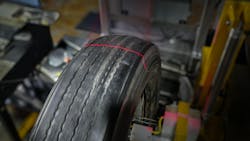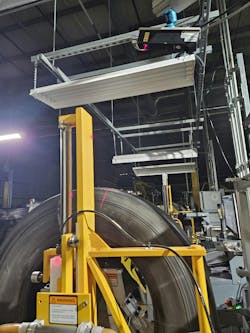Michelin scales TreadEye depth sensing tool across U.S. retread network
- Maximization of rubber on the road by avoiding early pulls;
- Early warning system for casing damage,
- Reduce DOT violations and downtime from late pulls;
- Improved efficiency in the tire removal process
MRT nine-step process
- Initial inspection: detect subtle irregularities that may indicate internal damage
- Buffing: Uses computer-aided sensors to obtain under tread of optimal profile, depth, and texture
- Casign integrity Two-step laser photography performed on every tire - Reveals belt separations or blisters within the belts or other not visible areas
- X-ray Available and used when needed – Allows visual inspection of the steel belts within the casing
- Repair best practice repairs – Thermal curing along with mechanical pressure exceeds industry standards
- Tread building Uses MICHELIN® tire tread – Combines two operations into one: applying hot cushion gum and pre-molded tread
- Double enveloping - use of inner envelope applies pressure to both sides of the repair – Ensures every retread surface undergoes uniform pressure and temperature
- Curing Computer controlled for minimum temperature variations – Achieves optimal uniformity and enhances full integration of all repairs
- Final inspection Assurance of the best retread every time – Thorough inspection of crown, sidewall, bead and interior – we make sure your retread is for the road
About the Author

John Hitch
Editor-in-chief, Fleet Maintenance
John Hitch is the award-winning editor-in-chief of Fleet Maintenance, where his mission is to provide maintenance leaders and technicians with the the latest information on tools, strategies, and best practices to keep their fleets' commercial vehicles moving.
He is based out of Cleveland, Ohio, and has worked in the B2B journalism space for more than a decade. Hitch was previously senior editor for FleetOwner and before that was technology editor for IndustryWeek and and managing editor of New Equipment Digest.
Hitch graduated from Kent State University and was editor of the student magazine The Burr in 2009.
The former sonar technician served honorably aboard the fast-attack submarine USS Oklahoma City (SSN-723), where he participated in counter-drug ops, an under-ice expedition, and other missions he's not allowed to talk about for several more decades.

